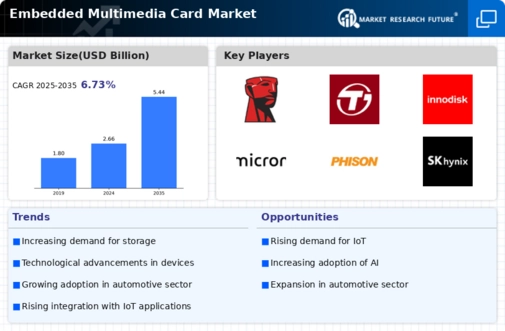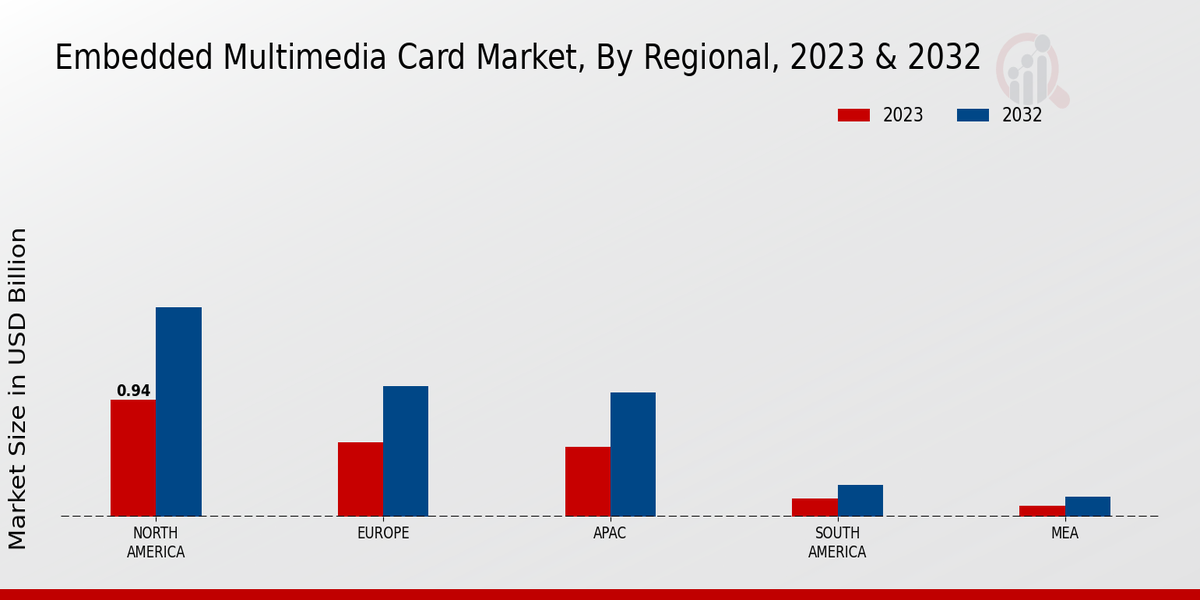Market Growth Projections
The Global Embedded Multimedia Card Market Industry is projected to experience substantial growth in the coming years. With a market value of 2.66 USD Billion in 2024, it is anticipated to reach 5.44 USD Billion by 2035, reflecting a robust growth trajectory. The compound annual growth rate (CAGR) of 6.73% from 2025 to 2035 indicates a sustained demand for embedded multimedia cards across various applications. This growth is driven by factors such as the increasing adoption of mobile devices, advancements in automotive technology, and the rise of IoT devices. The market's expansion is indicative of the critical role that eMMCs play in modern technology.
Emergence of 5G Technology
The Global Embedded Multimedia Card Market Industry is likely to benefit from the emergence of 5G technology. As 5G networks roll out globally, the demand for devices capable of leveraging high-speed connectivity increases. eMMCs play a crucial role in enabling the performance of these devices, providing the necessary storage for data-intensive applications. The integration of eMMCs in 5G-enabled devices enhances their functionality and user experience. This trend suggests a promising outlook for the market, as the proliferation of 5G technology is expected to drive demand for embedded multimedia cards across various sectors, including telecommunications and consumer electronics.
Growing Demand for Mobile Devices
The Global Embedded Multimedia Card Market Industry experiences a notable surge in demand driven by the proliferation of mobile devices. As smartphones and tablets become ubiquitous, the need for efficient storage solutions intensifies. Embedded Multimedia Cards (eMMCs) provide a compact and reliable storage option, catering to the increasing data storage requirements of these devices. In 2024, the market is projected to reach 2.66 USD Billion, reflecting the growing reliance on mobile technology. This trend is expected to continue, with the market potentially expanding as consumer preferences shift towards devices that offer enhanced performance and storage capabilities.
Increasing Adoption of IoT Devices
The Global Embedded Multimedia Card Market Industry is poised for growth due to the increasing adoption of Internet of Things (IoT) devices. As smart home technologies and industrial IoT applications proliferate, the need for reliable and efficient storage solutions becomes paramount. eMMCs offer the necessary performance and durability for these devices, facilitating seamless data processing and storage. This trend is expected to drive the market forward, with a projected compound annual growth rate (CAGR) of 6.73% from 2025 to 2035. The integration of eMMCs in IoT devices enhances their functionality, making them indispensable in various sectors, including healthcare, agriculture, and smart cities.
Advancements in Automotive Technology
The Global Embedded Multimedia Card Market Industry is significantly influenced by advancements in automotive technology. As vehicles become more connected and autonomous, the demand for high-capacity storage solutions increases. eMMCs are integral to the functioning of infotainment systems, navigation, and advanced driver-assistance systems (ADAS). The automotive sector's transition towards electric and smart vehicles further propels the need for efficient storage solutions. This trend is likely to contribute to the market's growth, with projections indicating an increase in market value to 5.44 USD Billion by 2035, underscoring the importance of eMMCs in modern automotive applications.
Rising Demand for Consumer Electronics
The Global Embedded Multimedia Card Market Industry is significantly impacted by the rising demand for consumer electronics. With the continuous evolution of gadgets such as cameras, gaming consoles, and wearables, the need for efficient storage solutions is paramount. eMMCs provide a compact and high-performance storage option that meets the requirements of modern consumer electronics. As the market evolves, the demand for eMMCs is expected to grow, contributing to the overall market value. The increasing consumer preference for devices with enhanced storage capabilities indicates a robust future for the embedded multimedia card market, aligning with the projected growth trajectory.












